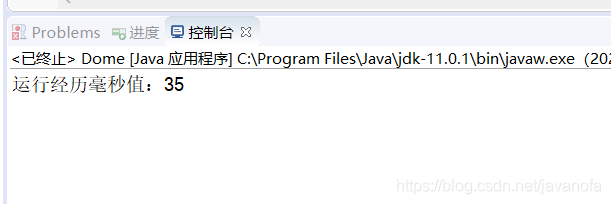带缓存的输入/输出流
BufferedInputStrean 与 BufferedOutputStream类
缓存是I/O的一种性能优化,缓存流为I/O流增加了内存缓存区,有了缓存区,可以大大提升运行效率。
举个例子,现在有A,B两个点,A点有货物需要搬到B点,如果采用人工搬运的方式,一次只可以搬运一个货物,效率非常低。
如果我们换一种方式,开一辆车,如果这车足够大的话,可以把货物全部装下,一次运到B点,这大大提高了工作效率。
缓存区的作用就相当于这个车。缓存输入/输出流的使用方法与文件输入/输出流的使用方法很像,缓存输入/输出流,嵌套在文件输入/输出流中。
举个例子,我要读取我位于桌面的Java API,的数据
代码如下:
public class Dome {
public static void main(String[] args) {
// 创建文件对象,文件为我位于桌面上的Java,api
File f = new File("C:\\Users\\逢青\\Desktop\\jdk api 1.8.CHM");
FileInputStream in = null;
long start = System.currentTimeMillis();// 程序开始时间
try {
in = new FileInputStream(f);// 创建FileInputStream对象
byte b[] = new byte[1024];// 创建byte数组储存读取的信息
while (in.read(b) != -1) {
// 循环遍历输出,读取信息
}
long end = System.currentTimeMillis();// 程序结束时间
System.out.println("运行经历毫秒值:" + (end - start));
} catch (FileNotFoundException e) {
e.printStackTrace();
} catch (IOException e) {
e.printStackTrace();
} finally {
if (in != null) {
// 判断in是否为空值,如果不是则关闭流
try {
in.close();// 关闭流
} catch (IOException e) {
e.printStackTrace();
}
}
}
}
}
这是没有添加缓存区的,用了143毫秒
我们添加缓存区
public class Dome {
public static void main(String[] args) {
// 创建文件对象,文件为我位于桌面上的Java,api
File f = new File("C:\\Users\\逢青\\Desktop\\jdk api 1.8.CHM");
FileInputStream in = null;
BufferedInputStream bi = null;
long start = System.currentTimeMillis();// 程序开始时间
try {
in = new FileInputStream(f);// 创建FileInputStream对象
bi = new BufferedInputStream(in);//创建BufferedInputStream对象
byte b[] = new byte[1024];// 创建byte数组储存读取的信息
while (bi.read(b) != -1) {
// 循环遍历输出,读取信息
}
long end = System.currentTimeMillis();// 程序结束时间
System.out.println("运行经历毫秒值:" + (end - start));
} catch (FileNotFoundException e) {
e.printStackTrace();
} catch (IOException e) {
e.printStackTrace();
} finally {
if(bi != null) {
// 判断bi是否为空值,如果不是则关闭流
try {
bi.close();// 关闭流
} catch (IOException e) {
e.printStackTrace();
}
}
if (in != null) {
// 判断in是否为空值,如果不是则关闭流
try {
in.close();// 关闭流
} catch (IOException e) {
e.printStackTrace();
}
}
}
}
}
效率提升的一半多,用了35毫秒
BufferedReader 与 BufferedWriter类
缓存字符流BufferedReader与BufferedWriter最大的特点是可以以行为单位进行输入/输出
| 方法 | 作用 |
|---|---|
| readLine() | 读取一行文本 |
| newLine() | 写入时创建新行 |
写个例子:
public class Study2 {
public static void main(String[] args) {
File f = new File("word.txt");// 创建文件对象
FileWriter fw = null;
BufferedWriter bw = null;
try {
fw = new FileWriter(f);// 创建FileWriter对象
bw = new BufferedWriter(fw);// 将文件字符流包装成缓存字符流
String str1 = "抽刀断水水更流";
String str2 = "举杯消愁愁更愁";
bw.write(str1);// 写入第一句话
bw.newLine();// 创建新行,也就是换行
bw.write(str2);// 写入第二句话
} catch (IOException e) {
e.printStackTrace();
} finally {
if (bw != null) {
// 判断bw是否为空值,如果不是则关闭流
try {
bw.close();// 关闭流
} catch (IOException e) {
e.printStackTrace();
}
}
if (fw != null) {
// 判断fw是否为空值,如果不是则关闭流
try {
fw.close();// 关闭流
} catch (IOException e) {
e.printStackTrace();
}
}
}
}
}
实现了在写入的时候换行了
反过来也是可以的,在txt文件中写几行话。
代码如下:
public class Study2 {
public static void main(String[] args) {
File f = new File("word.txt");// 创建文件对象
FileReader fr = null;
BufferedReader br = null;
try {
fr = new FileReader(f);// 创建FileReader对象
br = new BufferedReader(fr);// 包装FileReader对象
String tmp = null;
int i = 1;// 计数器
while ((tmp = br.readLine()) != null) {
// 循环读取文件中的信息
System.out.println("第" + i + "行:" + tmp);
i++;
}
} catch (FileNotFoundException e) {
e.printStackTrace();
} catch (IOException e) {
e.printStackTrace();
} finally {
if (br != null) {
// 判断br是否为空值,如果不是则关闭流
try {
br.close();// 关闭流
} catch (IOException e) {
e.printStackTrace();
}
}
if (fr != null) {
// 判断fr是否为空值,如果不是则关闭流
try {
fr.close();// 关闭流
} catch (IOException e) {
e.printStackTrace();
}
}
}
}
}
运行效果截图:







